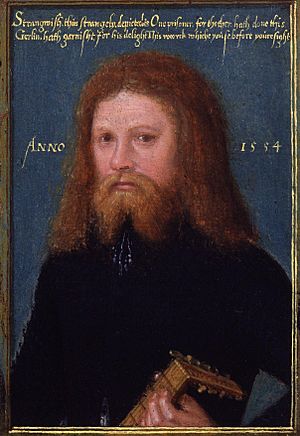Henry Strangways (pirate) facts for kids
Quick facts for kids
Henry Strangways
|
|
|---|---|

Strangwish 1554 by Flicke
|
|
| Born | fl. 1552 |
| Died | 1562 |
| Piratical career | |
| Nickname | Henry Strangwish |
| Type | Pirate |
Henry Strangways (died 1562), also known as Strangwish, was an English "Gentleman Pirate." He attacked Spanish ships and other vessels. He was often put in prison, but powerful friends helped him get pardoned many times during his eight years as a pirate, from about 1552 to 1560. A famous painting of him, made by a fellow prisoner named Gerlach Flicke, is now in the National Portrait Gallery in London.
The Life of Henry Strangways
Henry Strangways was born in Dorset. His family was well-known and respected. Because of his background, he was sometimes called a "Gentleman Pirate."
Strangways started his life as a pirate around 1552 or 1553. He sailed the Irish Sea, looking for treasure to steal. There, he teamed up with the Killigrew family from Cornwall, who were also successful pirates. They used Portland Castle as a secret hideout to store their stolen goods.
Strangways became so well-known that two warships were prepared in Portsmouth to catch him. He next appeared in records in 1555, when he was imprisoned in the Tower of London. However, he was soon released. This suggests he had powerful friends who helped him.
In 1559, Strangways was sentenced to death after being arrested with eighty of his men. But he managed to escape the punishment just before it happened.
That same year, in 1559, it was said he wanted to "steal an island" from Philip II of Spain. However, he focused on attacking Spanish ships instead. We know this because of an official complaint made to Philip II of Spain. It said that a ship belonging to Johannes de Bagnes was robbed by "Enrriex Tranquaz" (which was Strangways). This complaint was made through Basilio Pignatelli, the Bishop of L'Aquila.
Strangways was imprisoned again in December 1560, likely because of his attacks on Spanish ships. But he was released once more. This time, he promised to behave well. This further shows that he had strong connections or that his actions might have served a political purpose for England.
Henry Strangways died a free man in 1562. This was after his well-placed friends helped him get a pardon from Queen Elizabeth I. Because he received a Royal Pardon even after his death, and was released from jail many times, historians believe he might have been more of a "privateer" than just a pirate. A privateer was someone who attacked enemy ships with permission from their government.
His Famous Portrait
In 1554, during one of Strangways' times in prison, he became friends with another prisoner named Gerlach Flicke. Flicke was a portrait painter from Osnabrück, Germany, who had been working in England for about ten years. While they were in prison, Flicke painted a double portrait of himself and Strangways. We don't know why Flicke was in prison, but Strangways was there for his piracy.
The double portrait shows Strangways holding a lute, and Flicke holding his artist's palette. This painting is now in the National Portrait Gallery in London. Both portraits are very small, less than 4 inches (100 mm) high.
Flicke's self-portrait has a Latin message that means: "Such was the face of Gerlach Flicke when he was a painter in the City of London. This, he himself painted from a looking glass for his dear friends. So that they might have something to remember him after his death."
Even though both portraits are on the same piece of material, Strangways' portrait has a message in English. It says: "Strangwish, thus strangely depicted is One prisoner, for thother, hath done this/ Gerlin, hath garnisht, for his delight This woorck whiche you se, before youre sight."
Images for kids


